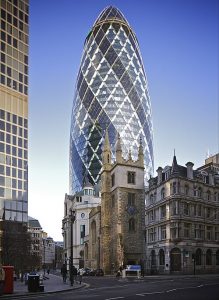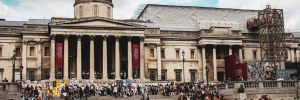
Designed by British architect Norman Foster and constructed between 2001 and 2003, the Gherkin was the first of a new generation of tall buildings that would go on to redefine London’s skyline. Before the Gherkin, London was not particularly renowned for its high-rise architecture; in fact, planning laws had historically kept the city’s skyline relatively low-rise, especially in contrast to American cities like New York City.
New York City, with its towering skyscrapers like the Empire State Building and One World Trade Center, had always been the emblem of vertical cityscapes. The island of Manhattan, constrained by its narrow geography, necessitated a skyward expansion, something that London, with its sprawling urban landscape, did not require. Thus, skyscrapers became a far more integral part of New York’s identity long before they did in London. However, the advent of the Gherkin marked a change in the British capital’s architectural narrative, signaling a greater openness to modern, towering structures. It catalysed the construction of other prominent skyscrapers like the Shard and the Leadenhall Building, also known as the ‘Cheesegrater,’ thereby marking a departure from London’s traditional architectural norms.
While the Gherkin and New York skyscrapers serve as a testament to human engineering and the ambition of modern cities, they also have a role in the historical narrative. During the construction of the Gherkin, an archaeological excavation led to the discovery of a Roman girl’s remains. The site on which the Gherkin was built had been part of Londinium, the Roman settlement that was the precursor to modern London. The Roman girl was reburied in a special ceremony, and her discovery offered a fascinating glimpse into London’s deep historical layers.
In contrast, New York City, being a much younger city, lacks this particular form of historical continuity. Whereas London’s architectural marvels often have to contend with, or integrate, layers of the city’s rich history dating back to Roman times, New York’s skyscrapers are typically built on land with a comparatively shorter human history. The historical context adds another dimension to the Gherkin, making it not just a feat of modern architecture but also a window into the rich tapestry of London’s past.
Thus, while the Gherkin may seem to emulate New York City’s towering edifices, it occupies a unique place within the larger narrative of London’s architectural and historical landscape. It serves as a bridge between London’s storied past and its continually evolving future, marking a fascinating juxtaposition between old and new that is seldom seen in younger cities like New York.




